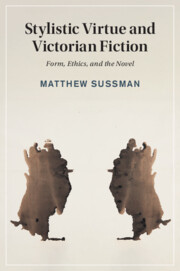Book contents
- Stylistic Virtue and Victorian Fiction
- Cambridge Studies In Nineteenth-Century Literature And Culture
- Stylistic Virtue and Victorian Fiction
- Copyright page
- Contents
- Illustrations
- Acknowledgments
- Introduction What Is Stylistic Virtue?
- Chapter 1 Stylistic Virtue and the Rise of Literary Formalism
- Chapter 2 Stylistic Virtue between Moralism and Aestheticism
- Chapter 3 Virtue Theory and the Nature of the Aesthetic
- Chapter 4 Thackeray’s Grace
- Chapter 5 Trollope’s Ease and Lucidity
- Chapter 6 Meredith’s Fervidness
- Afterword Stylistic Virtue and Literary Value
- Notes
- Bibliography
- Index
- Cambridge Studies In Nineteenth-Century Literature And Culture
Chapter 6 - Meredith’s Fervidness
Published online by Cambridge University Press: 11 June 2021
- Stylistic Virtue and Victorian Fiction
- Cambridge Studies In Nineteenth-Century Literature And Culture
- Stylistic Virtue and Victorian Fiction
- Copyright page
- Contents
- Illustrations
- Acknowledgments
- Introduction What Is Stylistic Virtue?
- Chapter 1 Stylistic Virtue and the Rise of Literary Formalism
- Chapter 2 Stylistic Virtue between Moralism and Aestheticism
- Chapter 3 Virtue Theory and the Nature of the Aesthetic
- Chapter 4 Thackeray’s Grace
- Chapter 5 Trollope’s Ease and Lucidity
- Chapter 6 Meredith’s Fervidness
- Afterword Stylistic Virtue and Literary Value
- Notes
- Bibliography
- Index
- Cambridge Studies In Nineteenth-Century Literature And Culture
Summary
The style of George Meredith represents an opposite extreme from Trollope: dense with epigram and ornament, it is frequently denigrated as extravagant and obscure, violating the realist conventions that Trollope worked hard to establish. However, Chapter 6 demonstrates how Meredith drew on the virtues of Asiatic and baroque styles to create a new form of psychological realism characterized by “fervidness,” the intensity that arises when contradictory principles are held in tension. On the one hand, Meredith gravitated to short forms like epigram to distill complex thoughts into memorable phrases; on the other, he delighted in the flights of fancy permitted by prosaic expansiveness. Through a consideration of major and minor work, this chapter reveals how fervidness is embodied structurally as a drama between conditions of freedom and constraint that impinge upon the development of central characters. In this way, Meredith’s “fervidness” formally replicates a dynamic that plays out thematically, making his style much more referential in terms of its relation to content than that of either Thackeray or Trollope before him.
Keywords
- Type
- Chapter
- Information
- Stylistic Virtue and Victorian FictionForm, Ethics, and the Novel, pp. 144 - 166Publisher: Cambridge University PressPrint publication year: 2021

